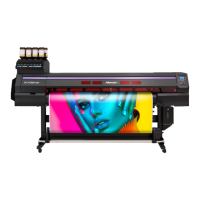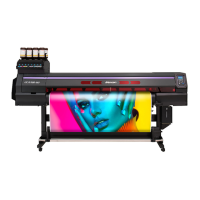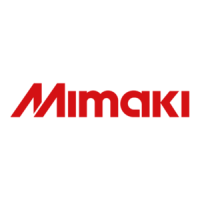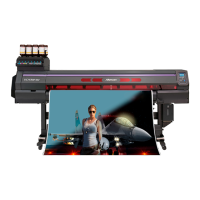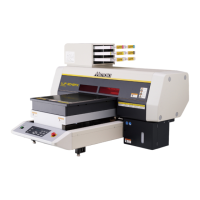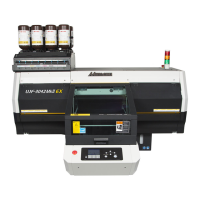How to clear clogged nozzles on my MIMAKI Printer?
- LLaura PayneAug 20, 2025
To clear clogged nozzles, you can try the following: * Perform head cleaning. * Perform print head nozzle washing. * Perform [MENU] > [Maintenance] > [INK FILL].
How to clear clogged nozzles on my MIMAKI Printer?
To clear clogged nozzles, you can try the following: * Perform head cleaning. * Perform print head nozzle washing. * Perform [MENU] > [Maintenance] > [INK FILL].
What to do if the ink has leaked from my MIMAKI UCJV300?
If an ink leak occurs, immediately turn off the main power and unplug the power cable. Then, contact your local dealer or our service office.
What to do if the light-blocking cover comes off my MIMAKI Printer?
If the light-blocking cover comes loose, reattach it by following these steps: 1. Insert the lug on one side of the light-blocking cover into the corresponding hole in the tank. 2. Insert the lug on the other side while pushing in toward the first hole.
Why does the media jam or get dirty in my MIMAKI Printer?
To address media jams or dirty media, consider the following: * Ensure you are using the recommended media. * Avoid using curled media or media with folded ends. * Use the take-up unit to adjust or reload the media.
How to fix image defects occurring on my MIMAKI UCJV300?
To address image defects, try the following: * Remove any paper scraps or debris from areas the head passes over, such as media holders. * Perform head cleaning. * Perform feed correction. * Clean the wiper. * Clean the cap rubber. * Clean the carriage underside.
How to correct misaligned print and cut positions on my MIMAKI UCJV300 Printer?
If the print and cut positions are misaligned, use the MIMAKI RIP software (RasterLink) to print a correction pattern. Then, check the pattern and manually input correction values.
Why does the cut position shift on my MIMAKI UCJV300?
If the cut position shifts, it may indicate a problem with the register mark sensor. Perform the operation used to check the responsiveness of the register mark sensor. Note that you cannot check the responsiveness manually.
How to troubleshoot a MIMAKI Printer when the power does not turn on?
To resolve the issue of the power not turning on, ensure the power plug is securely inserted into the power outlet, use the power cable provided, and turn on the main power.
Why is ID cut not performed on my MIMAKI Printer UCJV300/150, CJV300 Plus series?
If the UCJV300/150, CJV300 Plus series printer isn't performing ID cuts even after detecting register marks, ensure the following: * Establish a connection via USB or Ethernet. * Register the UCJV300/150, CJV300 Plus series with Cutting-Link. * Ensure that the register mark shape and size match the print register mark data on the UCJV300/150, CJV300 Plus series.
What to do if MIMAKI UCJV300 Printer doesn't cut continuously with multiple register marks?
If your MIMAKI UCJV 300/150 Printer doesn't cut continuously when multiple register marks with different IDs are attached, take these steps: * Ensure all register marks have the same shape and size. * Enter the correct settings under [cutting] - [register mark detection] - [detection area] on your UCJV 300/150.
Details regulations for Class A digital devices and potential interference.
Explains the meaning of symbols used in the manual for precautions.
Outlines safe operation precautions, including handling abnormal conditions and power supply.
Cautions regarding moving parts, disassembly, repair, and cutter handling.
Safety measures for UV light exposure, heat, and proper product disposal procedures.
Advises on preventing leakage, reading SDS, wearing PPE, and handling ink bottles safely.
Details ink type, color, capacity, expiration, and storage temperature requirements.
Explains ink expiration date implications and recommendations for use.
Guidelines for installation location, ventilation, drafts, vibration, sunlight, and temperature.
Details required clearance around the machine for safe operation and media replacement.
Advises contacting dealers for relocation and provides precautions for moving the machine.
Explains how interlocks ensure safety, aborting printing if covers are opened.
Illustrates locations and provides detailed explanations for various warning labels.
Identifies and summarizes parts on the front of the machine, including platen, carriage, and panel.
Identifies and summarizes parts visible from the rear and right side of the machine.
Detailed descriptions of carriage, platen, and capping station components.
Explains roller functions and the meaning of ink status lamp indicators.
Identification of media sensor, take-up unit, and power supply switch.
Details panel components, keys, status lamp, and display modes.
Details the four menu modes (LOCAL, REMOTE, MENU, NOT-READY) and ink status icons.
Lists [FUNCTION] key uses and how to access machine information.
Step-by-step instructions for connecting the power cable, including securing it.
Precautions for turning on the power, including closing covers.
Steps and checks required before turning off the machine's power.
Instructions for connecting via USB, including precautions and troubleshooting.
Instructions for connecting via LAN, including precautions.
How to check LAN status and precautions for network setup.
Overview of using RIP software to request print data from applications.
Instructions for installing the USB driver and locating the installation guide.
Steps for installing MIMAKI RIP software (RasterLink) and activating the license.
Explains how to select color profiles for consistent print quality based on media and ink.
Instructions for launching RasterLink and accessing the Printer Management screen.
Step-by-step guide to add and register the printer model, ink set, and connection port.
Advises on replacing ink bottles when levels are low, even if printing is possible.
Instructions for replacing ink bottles when ink has run out completely.
Precautions and steps for inserting the ink IC chip correctly into the slot.
Steps for removing ink bottles from cartons, shaking, and preparing them for installation.
Instructions for removing the lid and attaching the special cap securely, including leak checks.
Steps for installing ink bottles and details on their placement sequence based on ink set.
A step-by-step guide to the overall printing process, from powering on to loading media.
Covers loading media, adjusting pinch rollers, checking nozzles, cleaning, and adjusting feed/drop positions.
Instructions for printing RIP data and cutting the media.
Explains how to adjust the print head height to suit media thickness for optimal print quality.
Details how to adjust pinch roller positions for proper media grip and alignment.
Specific guidelines for adjusting pinch rollers for 1,600 mm media width.
Specific guidelines for adjusting pinch rollers for 1,300 mm media width.
Specific guidelines for adjusting pinch rollers for 1,070 mm media width.
Specific guidelines for adjusting pinch rollers for 750 mm media width.
Instructions for loading both roll and leaf media.
Detailed steps for moving roll holders, attaching media, and inserting rolls.
Further steps for securing media, checking alignment, and pulling media.
Instructions for checking media pull, securing it, and starting media width detection.
Explains how to adjust the torque limiter for the take-up unit tension.
Instructions for setting leaf media, which does not use roll holders.
Detailed steps for loading leaf media, including positioning and securing.
Final steps for securing leaf media and entering pinch roller usage.
Explains how to set pressure and quantity of pinch rollers based on media and tool.
How to print a test pattern to confirm ink prints correctly and identify defects.
Methods to check white ink ejection and examples of printing defects.
Details different head cleaning methods (Soft, Normal, Hard, Ultra) based on test print results.
Steps to print a correction pattern and enter values to adjust media feed amount.
How to adjust media feed amount in REMOTE mode or during printing.
Steps to print patterns and adjust drop position for bi-directional printing to prevent image defects.
Instructions on preparing image data and launching RasterLink.
Steps for selecting image data in RasterLink and checking/altering print settings.
How to alter print start position and begin printing.
Procedures for pausing, resuming, and stopping printing with data clear.
Steps to set the origin and cut the media using the CUT function.
A step-by-step guide to the cutting process, from powering on to setting cutting data.
Instructions for setting cutting data and cutting the media.
Instructions for installing cutters and pens.
Steps for adjusting blade protrusion and installing the cutter holder.
Continues the procedure for installing the cutter holder, including securing it.
Instructions for the SPA-0001 holder and adjusting blade protrusion.
Steps to remove cap, insert cartridge, and fit it to the spring.
Instructions for putting cap on adapter, inserting pen, and fixing pen nib.
Steps to select TOOL CHANGE, open cover, loosen screw, and insert pen holder.
Steps to insert pen holder/adapter into tool holder and secure it.
How to set cutting speed, pressure, offset, and half cut parameters.
How to perform test cuts to confirm tool conditions and troubleshoot common issues.
How to change the origin and start cutting.
Procedures for pausing, resuming, and stopping cutting with data clear.
How to retract the cutter unit from the platen after cutting is complete.
Outlines steps for creating, printing, preparing, registering, and detecting register marks for cutting.
Explains how to create register marks, their types, and limitations.
Recommended sizes, line widths, and spacing for register marks.
Detectable range, margins, and examples of mis-detection.
Areas to avoid plotting data and overview of the ID Cut process.
Notes on settings, data volume, and accuracy for combined operations.
How to set conditions for detecting printed register marks.
Procedure to detect the origin position of register marks using the LED pointer.
Outlines the steps for the ID Cut process, from data creation to cutting.
Explains saving print conditions (Settings 1-4, Temporary) for specific media.
Steps to copy temporary settings and details of menu items like Feed Comp.
Details setup items like OVER PRINT, DRYING TIME, Vacuum, Feed Speed, and Auto Cleaning.
Details remaining setup items: UV mode, MAPS4, Smoothing, Speed, Ionizer, LT Mode, Setup Reset.
Specifies LT mode conditions and instructions for renaming setting types.
Explains the purpose of the maintenance menu for actions like nozzle recovery and cleaning.
How to check for clogged nozzles and set automatic maintenance.
How to check machine information such as usage, ink levels, and versions.
How to set various parameters related to cutting functions.
General warnings and guidelines for periodic maintenance, cleaning, and handling liquids.
Lists daily and weekly maintenance tasks with their timing.
Lists maintenance supplies and steps to clean the wiper.
Detailed steps for pulling out, cleaning, and reattaching the wiper.
How to clean the wiper cleaner and cap rubber.
Steps for cleaning cap rubber and NCU sensor.
Steps to clean NCU and carriage underside/UV-LED lamp.
Detailed steps for cleaning the UV-LED lamp and print head underside.
Instructions for cleaning print head sides and mist filter.
How to replace mist filter and perform nozzle washing.
Detailed steps for nozzle washing, including cleaning wipers and caps.
Final nozzle washing steps and procedures for ink channel and sensor cleaning.
How to clean carriage sensors and the media holder.
Cleaning procedures for platen, covers, and when not in use.
Steps for performing custody wash, which involves cleaning wipers, caps, and filling with washing liquid.
Final steps after custody wash, including closing covers and not turning off the main power.
General information on ordering consumable items and detailed steps for wiper replacement.
How to replace the cap absorber when it is dirty or ink drips on media.
Detailed steps for removing, cleaning, and attaching a new cap absorber.
Final steps for cap absorber replacement and mist filter replacement.
How to replace the LED glass if ink hardens or it becomes dirty.
How to replace worn pinch rollers and the media holder.
Detailed steps for replacing the media holder, including removing stoppers and sliders.
Steps for attaching new holder and replacing media cutter.
Steps for replacing media cutter and exhaust fan filter.
Steps for replacing exhaust fan filter and waste ink tank.
Detailed steps for replacing the waste ink tank, including adjusting the level and opening the cover.
Final step to close the cover and press [ENTER] to reset the level.
Information on replacing cutters and pen lines.
Instructions for opening the front cover, peeling off the pen line, attaching tape, and attaching the pen line.
Checks and corrective actions for power, printing, and media-related problems.
Corrective actions for image defects, ink leaks, and ink color issues.
Steps for performing air purge, including selecting heads and connecting the jig.
Steps to correct misalignment and adjust the register mark sensor position.
Procedures for sensor adjustment and correcting LED pointer position.
How to investigate cutting failures and correct printing/cutting misalignment.
Steps to adjust RasterLink settings for misalignment correction.
Lists warning messages, their causes, and corrective actions.
Lists more warning messages and explains ink errors.
Lists error messages related to ink IC chips, color, type, and expiration.
Lists error messages for hardware problems like PCB, USB, and SDRAM.
Lists error messages related to motors, sensors, carriage, and media width.
Lists error messages for sensors, ionizer, pump motor, ink overflow, and negative pressure.
Lists error messages related to pressure, NCU, and ink heater.
Lists error messages for PCB voltage, command, parameter, data, and sheet size issues.
Lists error messages for PCB, detection failures, and system halt.
Details specifications for print head, resolution, ink set, media, and print margins.
Covers reproducibility, skew, printing gap, interface, noise levels, and power.
Details external dimensions (width, depth, height) and weight for different models.
Details specifications related to cutting functions, including speed, pressure, and usable tools.
| Print Technology | UV-LED inkjet |
|---|---|
| Max Print Resolution | 1200 x 1200 dpi |
| Power Supply | AC 100-240 V, 50/60 Hz |
| Ink Type | UV-curable ink |
| Media Thickness | 1 mm or less |
| Interface | USB, Ethernet |
| Operating System Compatibility | Windows 10, Windows 8.1, Windows 7 |
| Ink Colors | CMYK, White, Clear |
